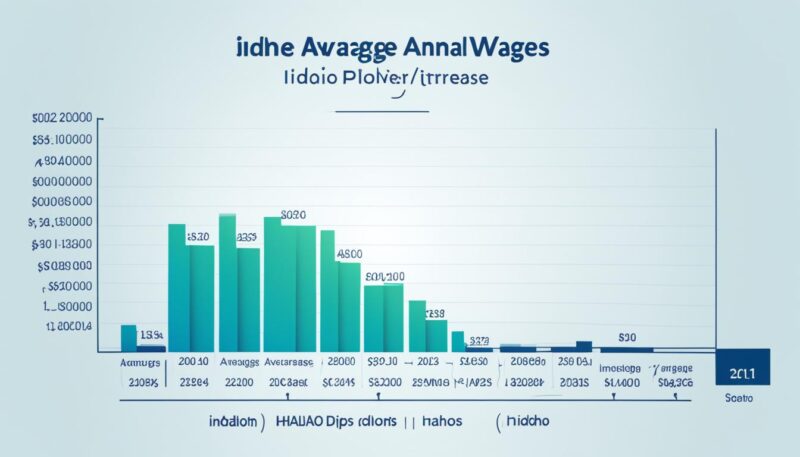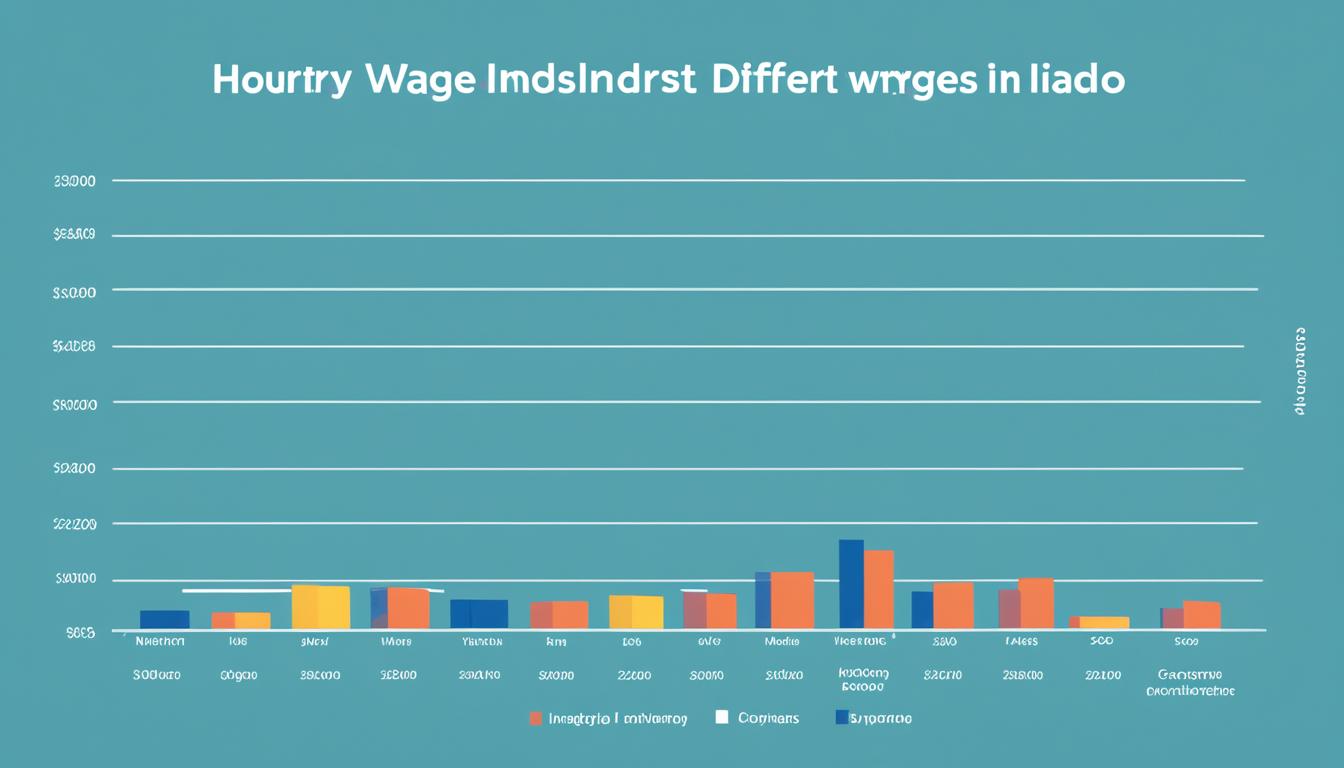As the financial year 2024 unfolds, the labor market in Idaho presents a complex tapestry of economic data and trends. Wages in Idaho 2024 have taken a pivotal role in shaping the state’s economy, as businesses and employees alike adapt to new realities. Idaho job wages data become invaluable in this context, giving us crucial insight into the ongoing shifts within various industries. Coupled with this, Idaho labor market statistics serve as a compass for understanding the broader economic health of the state, influencing both policy-making and personal career decisions.
With an eye on the dynamic interplay of market forces, this analysis probes into the depths of wage figures and forecasts. It aims to demystify the intricacies of the state’s compensation levels and set the scene for a thorough exploration of what these numbers truly mean for the citizens of Idaho.
Key Takeaways
- In-depth understanding of current wage levels and trends across Idaho’s diverse industries.
- Insight into how Idaho job wages data shapes the state’s labor market landscape in 2024.
- A look at how current wages square with living costs and economic stability.
- The implications of Idaho labor market statistics on future employment and economic policies.
- Forward-looking analysis on the predicted growth and challenges in the wage sector.
Analysis of Current Idaho Minimum Wage Rates
Idaho’s landscape for minimum wage in 2024 continues to be a critical factor in the economic well-being of its workforce. As we delve into an examination of the Idaho minimum wage rates, it is evident that the trajectory of these rates not only mirrors the historical legislative adjustments but also reflects a response to the cost of living and labor demands.
The evolution of the minimum wage in Idaho has been marked by incremental steps and legislative action, which have attempted to balance economic growth against the purchasing power of citizens. To understand the implications for employees dealing with the Wages in Idaho 2024, it’s important to look at the raw numbers provided by the Idaho Department of Labor, supported by commentary from distinguished economic analysts.
Employers and workers alike have vested interest in the current minimum wage rates as they ultimately dictate the baseline for the workforce compensation. Below is a comprehensive breakdown of Idaho’s minimum wage rates as of 2024:
| Year | Minimum Wage | Percentage Increase from Previous Year |
|---|---|---|
| 2020 | $7.25 | – |
| 2021 | $7.25 | 0% |
| 2022 | $8.75 | 20.69% |
| 2023 | $9.50 | 8.57% |
| 2024 | $10.25 | 7.89% |
It is clear from the table above that the state of Idaho has recognized the need for a gradual rise in the minimum wage. In 2024, the increase to $10.25 represents not just a response to inflationary pressures but also a legislative intent to improve the standard of living for hourly workers.
An expert at the Idaho Department of Labor stated, “The increase in the Idaho minimum wage rates for 2024 is a step towards ensuring a fair wage for the state’s workers, enabling them to meet living expenses with dignity.”
While the adjustment provides some relief, voices from the economic and labor community continue to raise the question of whether these rates are sufficient in relation to the dynamic market and cost of living variables in Idaho.
- Buying Power: Comparison of minimum wage versus living costs.
- Employer Response: Analysis of how businesses adjust to increased labor costs.
- Employee Impact: Real stories of how changes in minimum wage influence day-to-day living.
In summary, the changes in the minimum wage rates are more than mere figures; they are indicative of the state’s economic ethos towards its labor force. It advocates for a continual evaluation of the living wage that considers the reality of economic flux, guiding the discussion of Wages in Idaho 2024 into broader debates on sustainability and quality of life for Idahoans.
Idaho Salary Trends and Their Implications
As Idaho continues to navigate through the fiscal year of 2024, understanding the dynamics of its wage increases is critical for policymakers, businesses, and employees alike. Insightful analysis of Idaho salary trends not only indicates the health of the state’s economy but also helps in forecasting future growth patterns and the potential need for strategic economic adjustments. In this section, we will explore the various facets of salary changes within the region, with a particular focus on year-over-year growth trends, comparisons to national averages, and adjustments related to the cost of living.
Year-Over-Year Growth in Different Sectors
The Idaho labor market has exhibited varying rates of wage growth across different sectors. Some industries have seen robust increases, influenced by market demands, technological advancements, and regulatory changes. For instance, the technology and healthcare sectors have reported notable increases, reflecting a nationwide surge in demand for these professionals. However, as with all economic developments, this growth is uneven, with some sectors such as retail and hospitality showing more modest wage escalations.

Comparing Idaho’s Wage Growth to National Averages
Comparative analysis illustrates that while Idaho’s salary trends generally mirror national trends, there are distinct divergences. When juxtaposed with the national averages, Idaho’s wage growth in certain sectors like manufacturing and construction outpaces the broader national wage increases. Yet other sectors trail behind, prompting a call to action for economic strategists to identify areas where Idaho can bolster wage growth to remain competitive on a national scale.
The Impact of Cost of Living Adjustments on Idaho Salaries
Finally, the interaction between salary trends and the cost of living adjustments in Idaho is complex. While some wage increases in Idaho closely align with cost of living adjustments, ensuring that workers maintain their purchasing power, there are concerns that in certain areas wages are not keeping pace. This discrepancy could have a ripple effect on Idaho’s economy, influencing talent retention, consumption patterns, and even residential affordability.
Understanding the trajectory of Idaho salary trends is more than an academic exercise. It provides invaluable data that can help shape Idaho’s economic landscape for years to come. By analyzing these patterns, stakeholders can better navigate the evolving challenges of the Idaho labor market and position themselves for sustainable growth and prosperity.
Wages in Idaho 2024
The forthcoming year presents a critical juncture for Idaho’s labor market, with anticipated changes poised to influence the economic landscape. As Idaho continues to adapt to the shifting tides of commerce and labor, Idaho’s minimum wage rates and overall compensation patterns are at the forefront of discussions amongst policymakers and business leaders.
Projected Minimum Wage Adjustments
There is much speculation around the adjustments in minimum wage for Idaho come 2024. Analyzing current legislation trends and inflation rates, experts anticipate a potential uplift in the baseline compensation. This adjustment is aimed at fostering a more equitable economic environment and ensuring that the Idaho minimum wage rates remain competitive and sufficient to meet the basic living standards.
This advancement in minimum wage is believed to reflect positively not only on workers but also on the broader Idaho job wages data, possibly triggering an uptick in consumer spending and economic vitality in local communities.
Wage Predictions for Major Idaho Industries
Turning to industry-specific forecasts, the wage evolution within Idaho’s significant sectors such as agriculture, manufacturing, and technology is projected to diversify. Drawing on Idaho salary trends and Idaho job wages data, here’s what analysts predict:
- The technology sector might see an upward surge owing to continued innovation and demand for skilled labor.
- Manufacturing may experience moderate wage growth, balancing automation with workforce expertise.
- Agriculture wages are expected to be influenced by market demands and international trade agreements.
These industry shifts are fundamental to understanding and preparing for the state’s economic trajectory.
Long-Term Economic Projections and Their Effects on Wages
Examining the long-term economic projections and their effects on wages, there is an air of cautious optimism among economists. The correlation between Idaho’s projected economic growth and wages suggests potential for an overall increase in the average income levels. However, this optimism is tempered by the acknowledgment of external variables such as global economic trends, technological advancements, and demographic shifts.
Overall, navigating the intricacies of the Idaho labor market statistics will require a dynamic approach, as employees and employers alike adapt to the ever-evolving wages in Idaho 2024.
Idaho’s Labor Market Statistics
Diving into the most recent Idaho labor market statistics, the landscape of employment in this northern state can be better understood. Critical data representing the job wages and overall economic vitality places Idaho within a context of both challenges and growth. As we dissect Idaho job wages data, it becomes evident how employment rates, job growth, and unemployment figures correlate directly with trends in wage levels.
Employment rates in Idaho have consistently indicated the state’s resilience in various economic cycles. With an evolving job market, Idaho sees divergent trends across sectors, impacting wages and employment types. In particular, job growth statistics shine a light on which industries are advancing, setting the pace for an adaptive labor force.
Conversely, unemployment figures, which serve as a gauge for economic health, imply a broader narrative. Idaho’s unemployment rates have historically been lower than the national average, a testament to the state’s stable job market and opportunities for wage growth.
“Understanding the interplay between job growth and unemployment figures gives us critical insights into the health of Idaho’s economy and its labor force.”
Industry-specific wage data further elucidates the nuances of the state’s employment sectors, with healthcare, technology, and agriculture leading in job expansion. It’s in these areas that the relationship between available jobs and wage levels is most dynamically expressed, providing a multi-dimensional view of Idaho’s labor economics.
- Labor force participation rates
- Median household income
- High-growth occupational fields
- Regional employment variations
By scrutinizing this detailed labor market data, employers, job seekers, and policymakers can make informed decisions that contribute to the vitality of Idaho’s economy and the prosperity of its workforce.
Conclusion
As we reflect on Wages in Idaho 2024, it is clear that the state’s labor market has evolved significantly. The Idaho minimum wage rates have been a crucial factor for workers navigating the economic landscape. Despite these adjustments, challenges persist as individuals and businesses alike strive to adapt to the dynamic labor market. The intricacies of Idaho salary trends have been thoroughly dissected, offering invaluable insights towards understanding the broader implications for the state’s workforce and economy.
The analysis provided underscores the vital influence of wages on economic stability and growth. It is imperative for stakeholders to continually monitor these wage trends within Idaho, as they shape the opportunities and livelihoods of the population. Future considerations for wage policy and economic development must be judiciously assessed to foster a prosperous environment for all sectors. As we look ahead, it is paramount that wage progression aligns with the cost of living and economic realities, ensuring fair compensation for the hard work of Idahoans.
In summary, while the economic outlook for Wages in Idaho 2024 holds promise, it also presents a complex array of variables that must be carefully balanced. With astute policy-making and investment in the labor market, Idaho has the potential to create a resilient and flourishing economy that benefits employees and employers alike. The progression of wages remains a pivotal element in crafting the state’s economic narrative as we navigate through 2024 and beyond.
